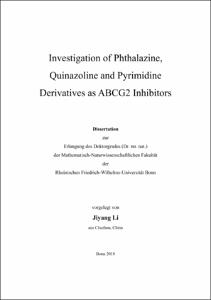Investigation of Phthalazine, Quinazoline and Pyrimidine Derivatives as ABCG2 Inhibitors

Investigation of Phthalazine, Quinazoline and Pyrimidine Derivatives as ABCG2 Inhibitors

| dc.contributor.advisor | Wiese, Michael | |
| dc.contributor.author | Li, Jiyang | |
| dc.date.accessioned | 2020-04-25T10:55:01Z | |
| dc.date.available | 2020-04-25T10:55:01Z | |
| dc.date.issued | 28.08.2018 | |
| dc.identifier.uri | https://hdl.handle.net/20.500.11811/7622 | |
| dc.description.abstract | Globally, cancer is the second leading cause of death. Chemotherapy is commonly used in the treatment of cancer. However, in clinic, a wide variety of cancers display resistance to chemotherapy leading to the failure of cancer therapy. This phenomenon is called multidrug resistance (MDR). MDR could occur via various mechanisms. An important mechanism is related to overexpression of drug efflux transporters, especially ATP-binding cassette (ABC) transporters. In the whole ABC transporter family, P-glycoprotein (ABCB1/P-gp), multidrug resistance associated protein 1 (ABCC1/MRP1) and breast cancer resistance protein (ABCG2/BCRP) are mostly reported to confer MDR. They efflux diverse structurally unrelated anticancer drugs outside of cells and reduce cytotoxic effects. To overcome multidrug resistance, a possible strategy is to develop potent inhibitors which target efflux transporters and inhibit the transportation process. In this study, we adopted the essential features which were depicted before and synthesized various phthalazine, quinazoline and pyrimidine derivatives as ABCG2 inhibitors. Hoechst 33342 and pheophorbide A assays were carried out by my colleague to investigate their inhibitory potency. In project 1 and 2, several compounds with phthalazine or quinazoline scaffold displayed moderate inhibitory activities against ABCG2. But, generally, they were less potent than corresponding 4-anilino-2-phenylquinazoline derivatives. In project 3 and 4, 2-phenylpyrimidine derivatives were synthesized and biologically evaluated. In comparison to Ko143 which is a very potent ABCG2 inhibitor, compound 61, 62, 71, 72, 81 and 82 showed comparable or even higher inhibitory efficacy. The structure activity relationship was discussed in the following chapters. Owing to the excellent potency of these substances, further in vitro and in vivo studies such as intrinsic cytotoxicity are on the way. | en |
| dc.language.iso | eng | |
| dc.rights | In Copyright | |
| dc.rights.uri | http://rightsstatements.org/vocab/InC/1.0/ | |
| dc.subject.ddc | 500 Naturwissenschaften | |
| dc.subject.ddc | 540 Chemie | |
| dc.subject.ddc | 610 Medizin, Gesundheit | |
| dc.title | Investigation of Phthalazine, Quinazoline and Pyrimidine Derivatives as ABCG2 Inhibitors | |
| dc.type | Dissertation oder Habilitation | |
| dc.publisher.name | Universitäts- und Landesbibliothek Bonn | |
| dc.publisher.location | Bonn | |
| dc.rights.accessRights | openAccess | |
| dc.identifier.urn | https://nbn-resolving.org/urn:nbn:de:hbz:5n-51722 | |
| ulbbn.pubtype | Erstveröffentlichung | |
| ulbbnediss.affiliation.name | Rheinische Friedrich-Wilhelms-Universität Bonn | |
| ulbbnediss.affiliation.location | Bonn | |
| ulbbnediss.thesis.level | Dissertation | |
| ulbbnediss.dissID | 5172 | |
| ulbbnediss.date.accepted | 08.05.2018 | |
| ulbbnediss.institute | Mathematisch-Naturwissenschaftliche Fakultät : Fachgruppe Pharmazie / Pharmazeutisches Institut | |
| ulbbnediss.fakultaet | Mathematisch-Naturwissenschaftliche Fakultät | |
| dc.contributor.coReferee | Bendas, Gerd |
Files in this item
This item appears in the following Collection(s)
-
E-Dissertationen (4470)




